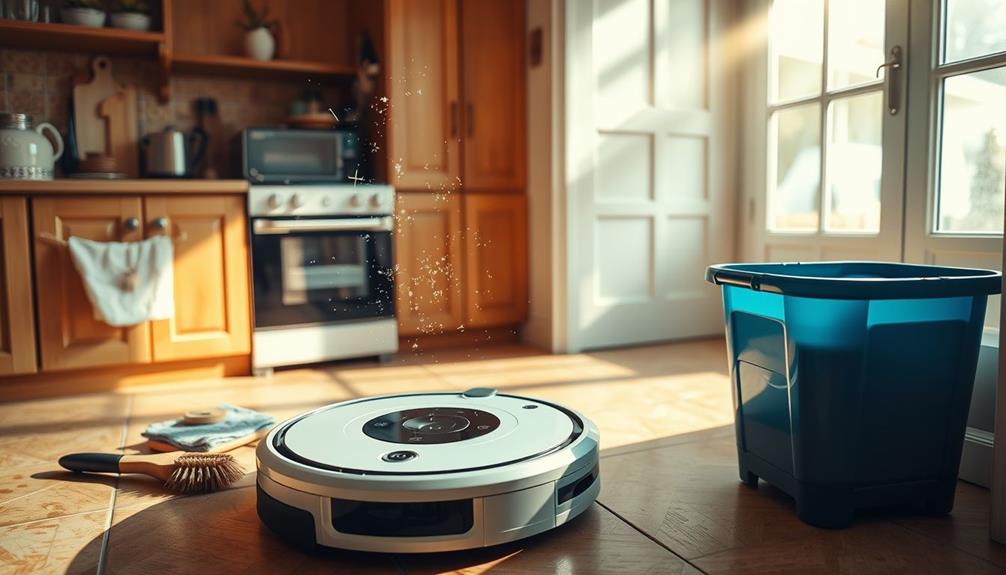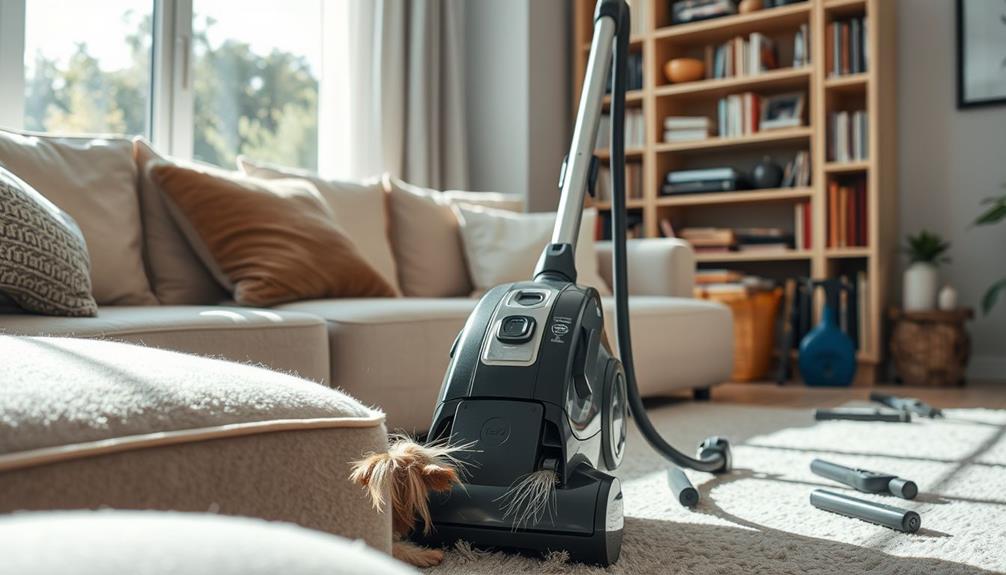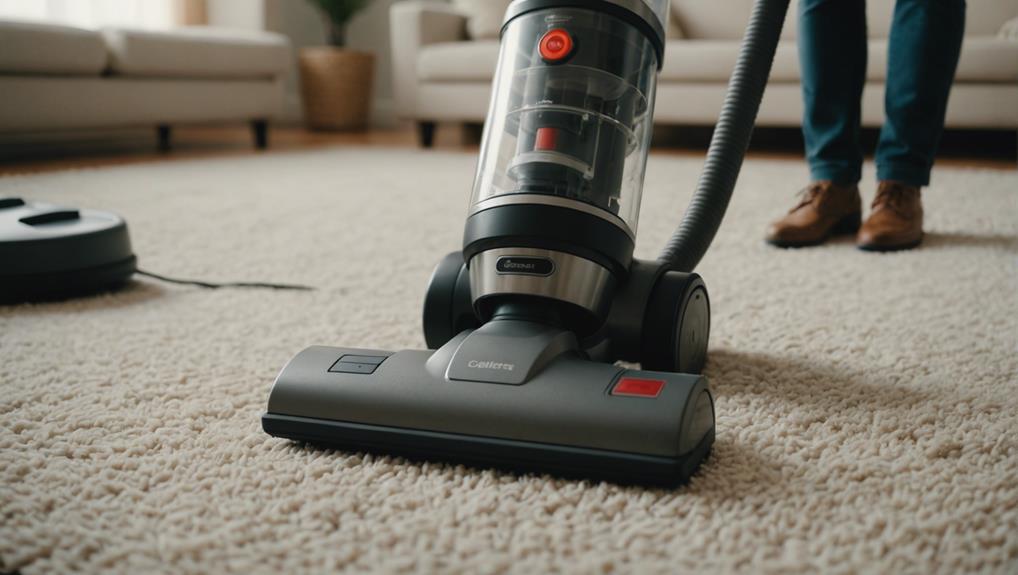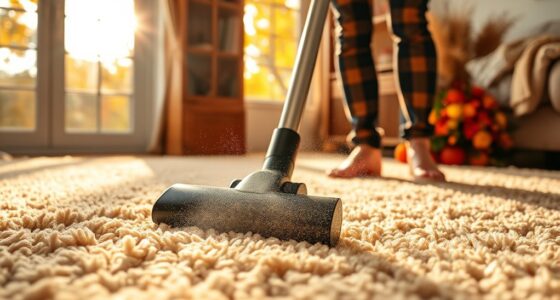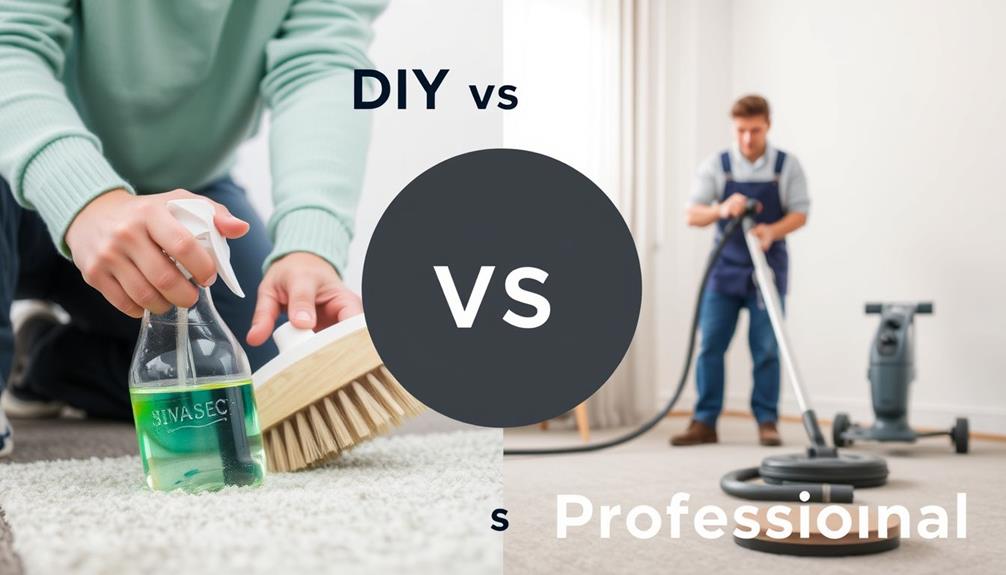In order to effectively clean and maintain your robot vacuum, begin by completing daily tasks such as emptying the dustbin after each use and inspecting the docking station. On a weekly basis, make sure to check brushes for tangles, wash them, and examine the wheels for any debris. Remember to frequently clean the air filters and wipe the sensors for optimal performance. It is also crucial to maintain the charging ports to prevent battery issues. Additionally, it is recommended to replace worn parts like brushes every 6-12 months. Regular maintenance not only improves efficiency but also prolongs the lifespan of your vacuum. You can discover more tips on how to keep your vacuum operating smoothly. Lastly, address any specific issues that may arise, such as removing fragrance oil stains from the vacuum’s surfaces. By regularly checking and maintaining your robot vacuum, you can ensure that it continues to function at its best and provide clean floors for many years. Always consult the manufacturer’s instructions for the best care practices for your particular model.
Key Takeaways
- Empty the dustbin after each cleaning session to maintain suction and prevent clogs.
- Inspect and clean brushes weekly, cutting away hair and strings for optimal performance.
- Regularly check and clean wheels to avoid debris entanglement and ensure smooth operation.
- Clean air filters weekly and replace them when necessary to maintain effective filtration.
- Wipe sensors and charging ports regularly to ensure accurate detection and reliable charging.
Importance of Regular Maintenance
Regular maintenance is vital for keeping your robot vacuum running at its finest. By committing to regular maintenance, you enhance the efficiency and longevity of your device, potentially extending its lifespan beyond the typical 8-10 years. Neglecting this upkeep can lead to reduced suction power and functionality, ultimately compromising your cleaning performance.
For instance, using vacuums designed for pet owners, like the Bissell Pet Hair Eraser Vacuum, can greatly improve hair removal efficiency and reduce the maintenance needed.
Spending just a few minutes each week on tasks like emptying the dustbin and cleaning filters can make a notable difference, especially if you have pets or children. Proper care prevents the buildup of dirt and debris, resulting in more effective cleaning results.
When you prioritize robot vacuum maintenance, you also reduce the risk of mechanical failures that could lead to costly repairs or replacements.
Establishing a consistent maintenance routine, including both weekly and monthly tasks, is essential for peak operation. By staying on top of these responsibilities, you guarantee your robot vacuum can tackle dirt and mess effectively, keeping your home clean and comfortable.
Cleaning Procedures and Frequency
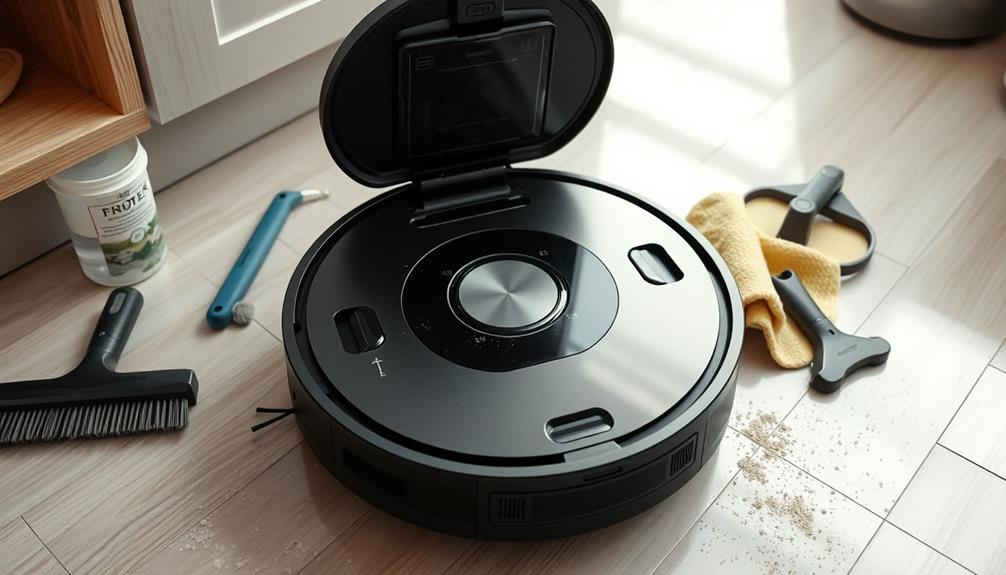
To keep your robot vacuum running smoothly, you should empty the dustbin daily. This simple task prevents clogs and maintains ideal suction.
Additionally, make it a habit to clean the brush rolls weekly to avoid hair and dirt buildup that can affect performance.
Regular maintenance not only enhances efficiency but also extends the lifespan of your device, which is similar to how you'd assess service offerings when hiring a cleaning company.
Daily Dustbin Maintenance
Maintaining your robot vacuum's dustbin is essential for ensuring peak performance. To keep your vacuum running smoothly, make it a habit to empty the dustbin after each cleaning session. This helps maintain ideal suction power and prevents clogs. If the dustbin is heavily soiled, rinse it with water but remember to remove all filters before washing. Additionally, clean any anti-tangle combs or other features on the dustbin to enhance overall efficiency.
For self-emptying models, don't forget to check and empty the docking station when it becomes full. Regular dustbin maintenance not only enhances performance but also avoids mechanical failures, helping to prolong your vacuum's lifespan.
Here's a quick reference for daily dustbin maintenance:
| Task | Frequency |
|---|---|
| Empty the dustbin | After each session |
| Rinse the dustbin | As needed |
| Check docking station | Daily |
Weekly Brush Cleaning Routine
A thorough weekly brush cleaning routine is crucial for keeping your robot vacuum performing at its best. Start by inspecting the main brush after each use for tangled hair or debris. Cutting-edge technology in modern vacuums enhances cleaning efficiency, similar to how robotic pool cleaners automate pool maintenance tasks. Cut away any obstructions to maintain peak cleaning performance.
For your weekly maintenance, remove the brush rolls and wash them with mild soap, guaranteeing they're thoroughly dried before reinserting them into the vacuum.
Don't forget about the side brushes. Check for bristle warping or tangling and restore their shape using a hair dryer, holding the bristles in place until they cool. This will help them function effectively during cleaning sessions.
Additionally, inspect the robot vacuum wheels for hair and debris entanglement. Use scissors or a utility knife to carefully remove any buildup, then wipe the wheels with a damp cloth to guarantee smooth operation.
Consistent brush cleaning and maintenance can greatly improve your robot vacuum's efficiency and prolong its lifespan, especially in homes with pets or heavy foot traffic. By taking the time to clean the brushes and wheels weekly, you'll keep your vacuum running smoothly and effectively for years to come.
Care for Brushes and Wheels

To keep your robot vacuum running smoothly, you need to pay attention to the brushes and wheels. Regular maintenance, like checking for tangled hair on the main brush and cleaning the wheels, can make a big difference in performance.
Additionally, ensuring that the air quality in your home is ideal can enhance the vacuum's effectiveness, especially in reducing allergens and dust particles, as noted by the importance of air purifiers.
Let's go over some specific tips to help you care for these essential parts.
Main Brush Maintenance Tips
Keeping your robot vacuum's main brush in top shape is vital for ideal performance. Regular maintenance will guarantee your vacuum operates efficiently, especially if you have pets or a busy household.
Investing in a vacuum designed for pet hair management can also enhance your cleaning experience. Here are some key maintenance tips to keep in mind:
- Inspect the main brush after each use for tangled debris. Use a cleaning tool to cut away hair and strings without damaging the bristles.
- Wash the main brush with mild soap once a month. Make sure to thoroughly rinse and dry it before reinserting to prevent buildup.
- If you notice signs of wear, consider replacing the main brush every 6-12 months. A fresh brush is vital for effective cleaning.
After cleaning, guarantee the brush is securely reinstalled to avoid any operational issues during your next cleaning session.
Side Brush Care Techniques
Maintaining the side brushes of your robot vacuum is just as important as caring for the main brush. Regularly inspect your side brushes for tangling and warping; if you notice any issues, try heating the plastic bristles with a hair dryer to restore their shape.
To keep them clean, wipe down the bristles to remove dirt and debris, ensuring ideal performance for effective debris collection. Proper appliance maintenance not only enhances the efficiency of your robot vacuum but also prolongs its lifespan.
When it comes to thorough cleaning, don't hesitate to remove the side brushes as needed. You might need a screwdriver for this, but it's worth the effort to maintain functionality. After cleaning, reinstall them securely to keep everything in good working order.
Remember, side brushes should be replaced every 6-12 months, or sooner if the bristles become damaged or worn. This is essential for continued cleaning efficiency.
For best results, clean the area around the side brushes frequently to prevent hair and debris buildup, which can hinder performance.
Wheel Cleaning Procedures
The wheels of your robot vacuum play a crucial role in its cleaning efficiency, so regular attention is important.
Just as cats show emotional attachment and can experience stress if their environment isn't maintained, making sure your vacuum's wheels are clean and well-maintained will help your vacuum navigate smoothly and extend its lifespan.
Here are some quick maintenance tips to keep in mind:
- Check weekly: Look for hair and debris entanglement. Use scissors or a utility knife to cut away any stuck materials that could impede movement.
- Wipe down: Use a damp cloth to clean the wheels, removing sticky residue to improve traction. This helps enhance the robot's overall cleaning efficiency.
- Inspect axles: Regularly check the wheel axles for buildup. Keeping them clean guarantees smooth operation and prevents navigation issues.
Dustbin and Air Filter Maintenance
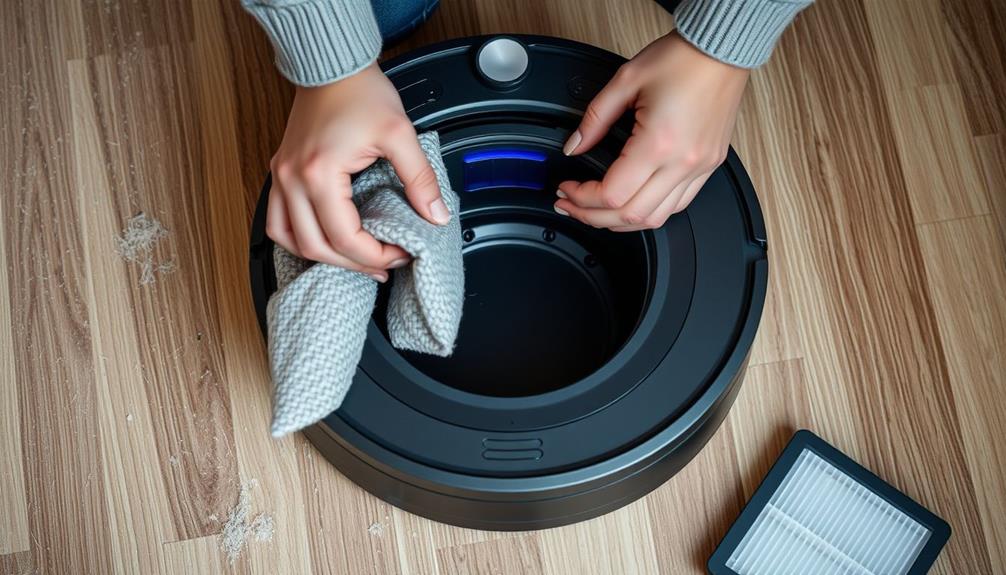
To guarantee your robot vacuum runs efficiently, regular attention to the dustbin and air filters is essential. Start by emptying the dustbin after each cleaning session, even if it doesn't seem full. This helps maintain maximum suction power and prevents clogs.
Additionally, maintaining a clean environment can support overall health, much like the importance of hydration in weight loss during treks.
Next, focus on the air filters. Clean them weekly or after each use by tapping them over a garbage bin to dislodge dust. For a thorough clean, use a soft brush to remove any remaining debris.
If your vacuum has washable filters, rinse them under cold water and let them air dry completely before reinstalling them. This step guarantees effective filtration.
If you own a self-emptying model, remember to check and empty the docking station when it's full to keep the self-cleaning feature working efficiently.
Additionally, if you notice any paper-based filters getting wet, replace them immediately. Always follow the manufacturer's guidelines for filter replacement schedules to guarantee your robot vacuum operates at peak performance.
Regular maintenance of the dustbin and air filters will help extend your vacuum's lifespan and enhance its cleaning capabilities.
Sensor and Charging Port Care
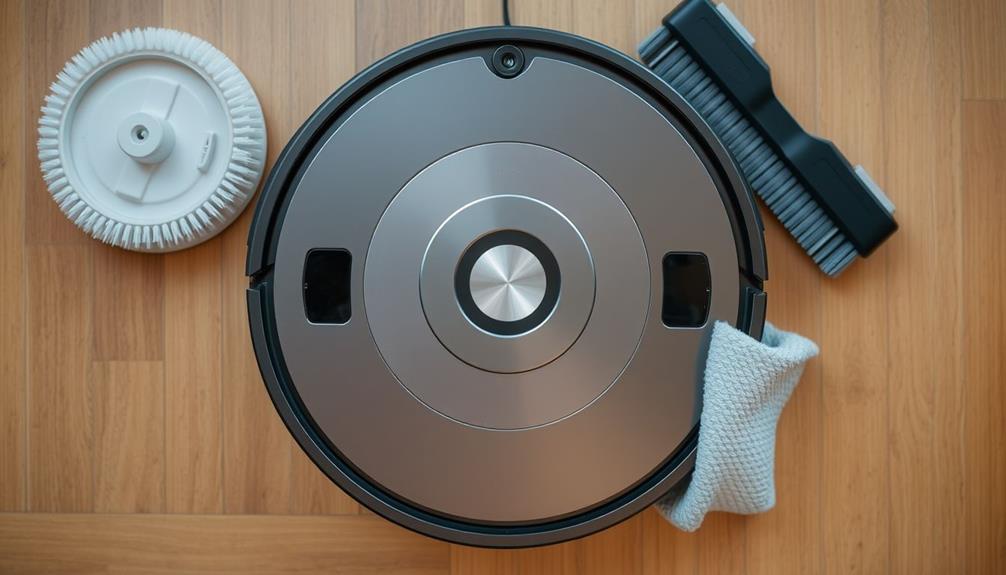
Keeping your robot vacuum's sensors and charging port clean is essential for ideal performance. Regular maintenance not only enhances navigation but also guarantees efficient charging.
Start by using a microfiber cloth to wipe the sensors located on the sides and bottom of your vacuum. This helps assure accurate obstacle detection and is akin to how modern ceiling fans enhance airflow for improved indoor air quality, as efficient air circulation is key in both scenarios. For stubborn dirt, dampen the cloth slightly, but steer clear of abrasive cleaners to prevent damage.
Additionally, inspect the charging port frequently for dust and debris that can interfere with the connection. Wipe it down with your microfiber cloth to keep it free from buildup.
Don't forget to check the charging contacts as well; grime here can lead to inefficient charging and battery issues over time.
Here are some quick tips to remember:
- Clean sensors regularly to avoid navigation problems.
- Use a damp microfiber cloth for tougher spots, but avoid harsh cleaners.
- Inspect for hair or dirt around the sensors and charging port.
Tips for Optimal Performance

For ideal performance, regularly cleaning and maintaining your robot vacuum is essential. Start by confirming that you clean your robot vacuum's brushes and filters frequently. This prevents dirt and hair buildup, which can reduce suction power and performance. Empty the dustbin after each use to avoid clogs and maintain maximum efficiency.
Consider scheduling automatic cleaning sessions and utilize smart features for better cleaning paths, which enhances overall efficiency. Also, adjust the vacuum's settings based on your floor type—this can greatly improve performance on both carpets and hard floors.
Here's a quick reference table for your maintenance routine:
| Maintenance Task | Frequency | Purpose |
|---|---|---|
| Clean Brushes | Weekly | Effective dirt and hair collection |
| Empty Dustbin | After Each Use | Prevent clogs and confirm suction |
| Clean Filters | Monthly | Maintain suction power |
| Check for Blockages | Monthly | Confirm smooth operation |
| Follow Manufacturer Guide | As Needed | Consistent care for longevity |
Frequently Asked Questions
How to Maintain Your Robot Vacuum?
To maintain your robot vacuum, start by emptying the dustbin after each use and cleaning the air filters weekly to keep suction power strong.
Inspect the brushes regularly, cutting away tangled hair and debris. Perform a deep clean of the brushes and wheels monthly to avoid buildup.
Don't forget to check the sensors with a microfiber cloth for accurate navigation. Following these steps will help extend your vacuum's lifespan and guarantee efficient cleaning.
How Often Should You Clean Your Robot Vacuum?
You should clean your robot vacuum regularly to keep it running smoothly.
After each cleaning session, empty the dustbin and check for debris in the wheels.
Once a week, clean the brush rolls and wheels to prevent hair buildup.
Monthly, do a deep clean of the brushes and inspect the sensors.
If you stay consistent with this schedule, you'll enhance your vacuum's performance and extend its lifespan greatly.
What Is the Best Cleaning Mode for a Robot Vacuum?
The best cleaning mode for your robot vacuum really depends on your flooring.
For carpets, you'll want to use a deep cleaning mode that boosts suction power.
If you have hard floors, a standard mode will do just fine, efficiently picking up dust and debris.
Don't forget to take into account smart mapping features; they can adapt cleaning modes based on your home's layout and dirt levels, ensuring peak performance during each session.
Do I Need to Service My Robot Vacuum?
Imagine your robot vacuum as a loyal steed, tirelessly trotting through your home. Yes, you do need to service it!
Regular maintenance keeps it galloping efficiently. Empty the dustbin daily and check for debris in the wheels to prevent clogs. Clean the brushes weekly and inspect them monthly for wear.
Neglecting these simple tasks can lead to a sluggish performance, costing you time and money in the long run. Keep your trusty companion in top shape!
Conclusion
By regularly maintaining your robot vacuum, you not only extend its lifespan but also guarantee it operates at peak efficiency. Did you know that a well-maintained vacuum can boost your home's air quality by reducing dust and allergens by up to 50%? That's a significant improvement for your health and comfort. So, take a few minutes each month to clean and care for your vacuum. Your home—and your lungs—will thank you!
